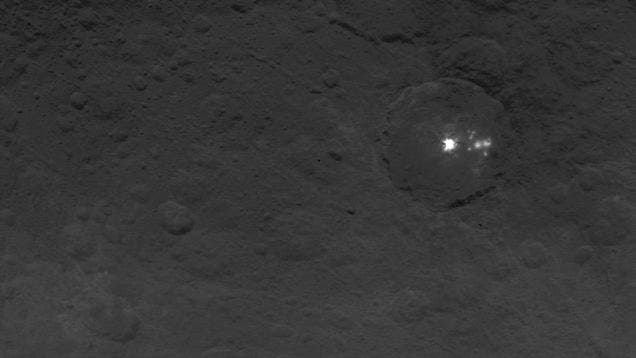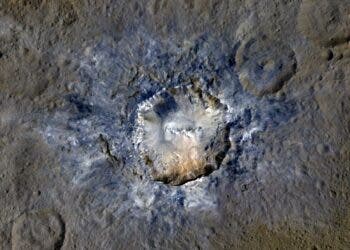NASA’s spacecraft Dawn is currently orbiting Ceres – a dwarf planet and the largest object in the asteroid belt – in order to study this highly fascinating, yet enigmatic object. For instance, strange and peculiar brights spots on its surface are still puzzling scientists. NASA has kindly shared some of the photos documenting these brights spots, taken by Dawn from only 2,700 miles above the surface.

When these bright spots were first spotted by NASA researchers, everybody was amazed. All indications point to a volcano-like origin of the spots, but no one could tell for sure until the spacecraft came closer. Even at 2,700 miles away, things aren’t clear yet what these spots, each about 6 miles wide nestled inside giant craters up to 50 miles wide, are supposed to be or how they formed.
Image: NASA
What’s certain is that the eight spots that have spotted so far are made up of some kind of reflective material, either ice or salt. Maybe even glass formed by impacts, considering all the spots are found inside craters. No alien cities I’m afraid.
“The surface of Ceres has revealed many interesting and unique features. For example, icy moons in the outer solar system have craters with central pits, but on Ceres central pits in large craters are much more common. These and other features will allow us to understand the inner structure of Ceres that we cannot sense directly,” Carol Raymond, deputy principal investigator for the JPL-based Dawn mission, said in the release.
Another interesting feature is a large, mountain-like peak that stands five miles high. That’s peculiar considering the rest of the dwarf planet’s surface is virtually flat. We’ll know more for certain once Ceres descends to a lower orbit.
Image: NASA“Dawn is the first mission to visit a dwarf planet, and the first to orbit two distinct targets in our solar system. It arrived at Ceres, the largest object in the main asteroid belt between Mars and Jupiter, on March 6, 2015,” read NASA’s release. “Dawn will remain in its current altitude until June 30, continuing to take images and spectra of Ceres in orbits of about three days each. It then will move into its next orbit at an altitude of 900 miles (1,450 kilometers), arriving in early August.”






